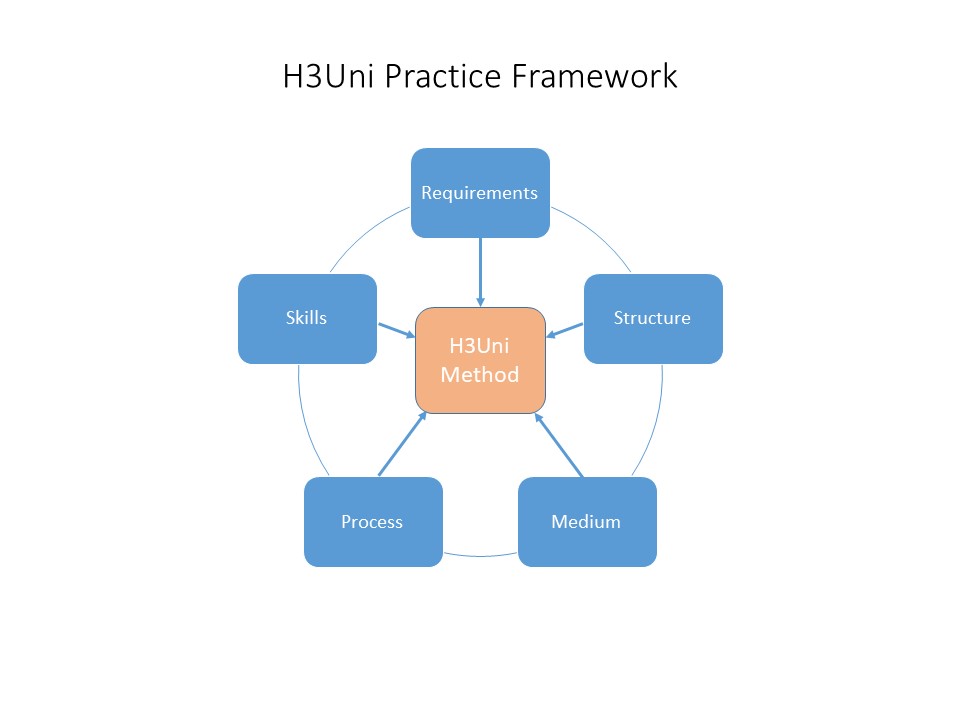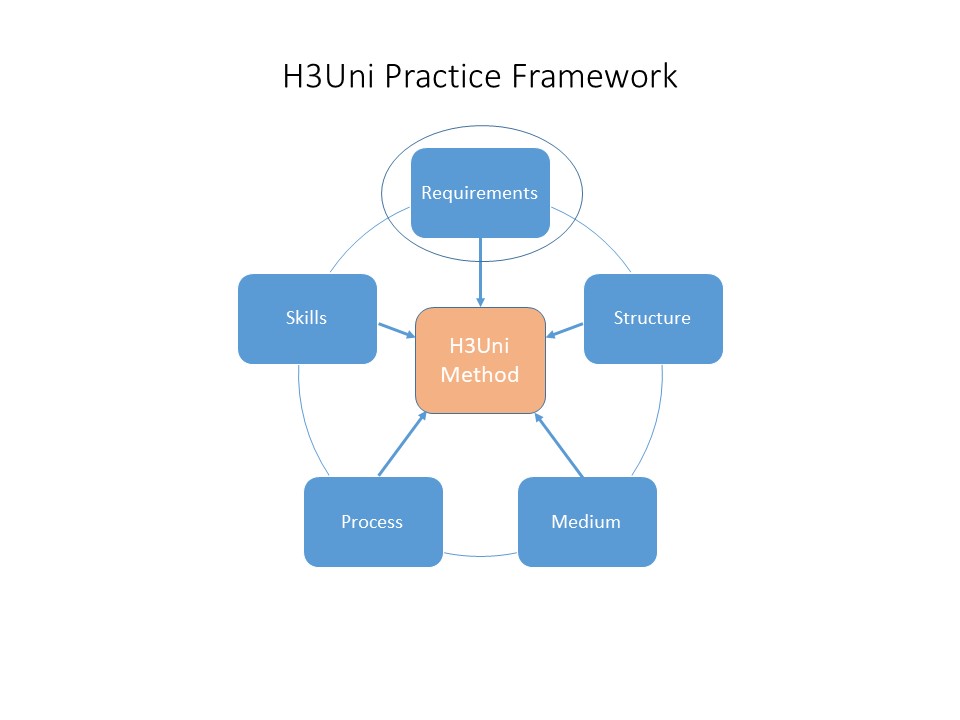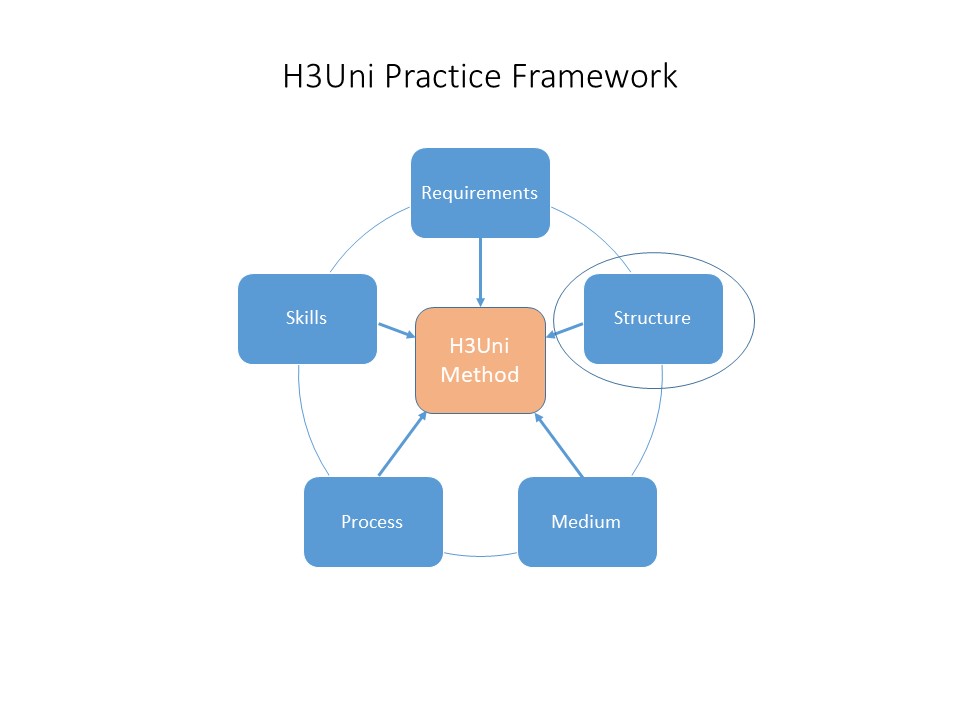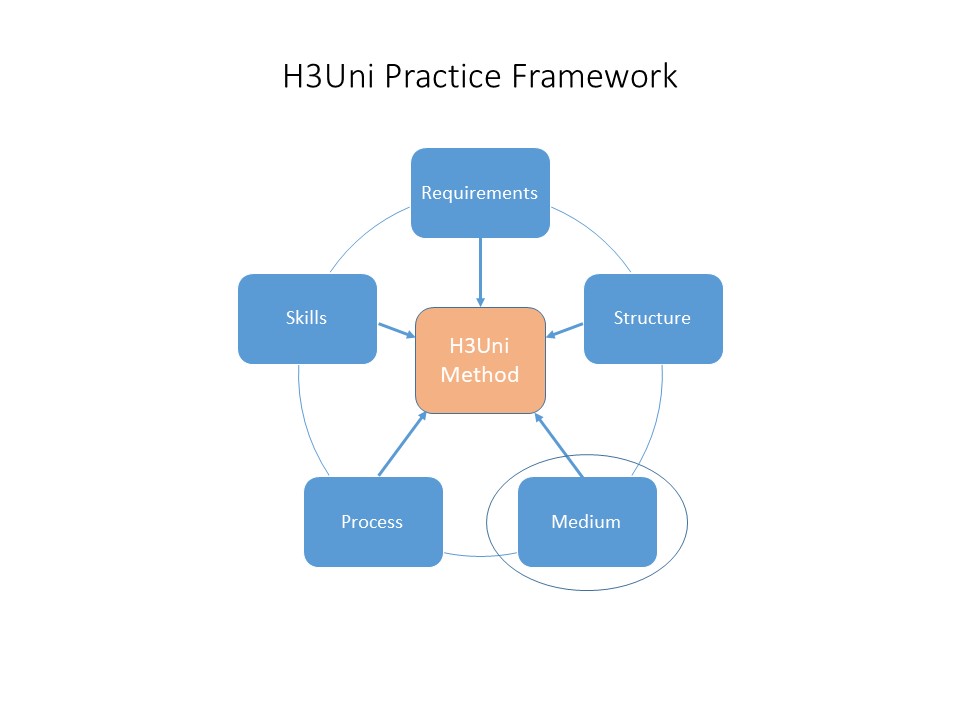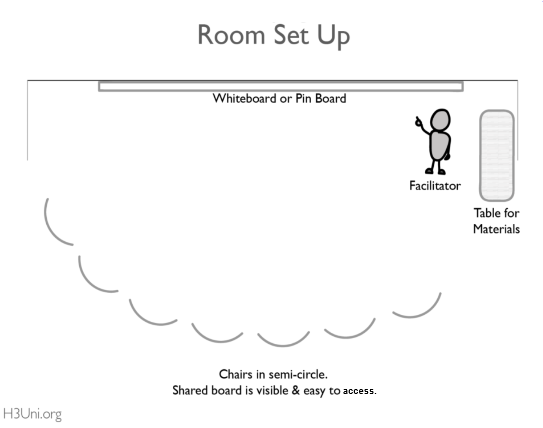Tutorial
H3Uni Practice Framework
H3Uni facilitation is an art for helping groups of people and teams to achieve higher than usual performance in their shared thinking and decision-making. It achieves this by the flexible use of techniques which make it easy to share information and ideas in a variety of visual formats through structured methods.
H3Uni facilitation is distinguished by its use of visual tools to aid group cognition and communication. By using symbolic media we get three advantages over conventional meeting formats:
- information is embodied, so content can be positioned and moved, and removed (unlike drawing on a piece of paper)
- ideas and information patterns can be deconstructed and reconstructed easily in real time.
- we can work with cognitive structures that are not confined by the grammar of language; this enables new patterns of connection to be rapidly explored.
- we can map and explore multiple relationships within powerful organizing concepts such as dilemmas, three horizons and systemic models
These processes and associated tools greatly enhance the potential for shared creative breakthroughs as well as enhanced mutual understanding.
We call this process ‘participative re-patterning’ as it allows everyone to take part in a dialogue in which they can take apart old ways of doing things and create shared intent around new patterns. We call the practice of facilitating teams in this way ‘Pattern Facilitation’.
The basics of H3Uni pattern facilitation are described in the Visual Facilitation Tutorial which should be read alongside this tutorial to give a background in the sort of methods that H3Uni facilitation works with.
Here we describe the wider framework for choosing and applying those methods.
H3uni Methods
For facilitating an overall group process you need be able to place the specific method to be facilitated in its wider context. This means understanding the client situation and matching your practice to that. This can be broken down into five components:
- requirements – what is the group trying to do?
- structure – what is the best thinking tool to use?
- medium – what is the material set up needed to carry this out?
- process – what is the sequence of steps required for application?
- skills – have I (and my colleagues) got the necessary capabilities?
The diagram above helps us keep these five components in mind, so we call it the H3Uni Fivefold Practice. At the centre is an H3Uni method which combines a specific thinking structure with process steps that you will take the group through in your role as facilitator – like a recipe in a cookbook that describes a dish, the ingredients, and the steps to make it.
Requirements: what is the group trying to do?
As a practitioner you need to appreciate that different purposes and circumstances require different forms and combination of process knowledge. This is a combination of organizational, psychological and technical appreciation. The most important factor is developing a confidence based on having a good feel for the group. For this it is necessary to:
Get to know your group
- who are they?
- what is their background?
- how well do they know each other?
- do they have a history to be taken into account?
Get to understand their challenge
- what are they trying to do?
- where are they in that process?
- how do they see their challenge?
- how do you see their challenge?
Judge what method(s) would be most helpful
- what does the nature of their challenge require – futures, dilemmas, systems, etc?
- what method(s) in the Resource Library matches that?
- Am I (we) sufficiently familiar with that to facilitate it at the level required?
Explain your approach to them before committing
- Have you briefed the group on the output you anticipate?
- Have you given the group a broad idea of the process they will go through?
- Have you ensured as far as possible you are getting the right people in the room?
You may have to take them with you first time through
- How familiar with this kind of process is the group?
- Is there anyone in the group who has been through one before?
- Are you allowing for time to explain and answer questions as well as drive the process?
The above is a fairly comprehensive list although there are always deeper layers of detail that sometimes have to be considered. A useful practice is to use these questions to reflect on whether you are setting yourself up to facilitate in the best possible way. Equally, if you neglect these areas of consideration don’t be surprised if you trip up at some point later in your project.
Where you will find this
In this Resource Library there are methods that are useful for establishing overall requirements for working with all the others:
- Strategic Issue Mapping (aka Hexagon Mapping) is an application of Thinking with Hexagons that is useful for an initial dialogue to clarify the nature of the challenge of sort of H3Uni approach that would be helpful.
- Scoping is a way to capture the top level scope and purpose within which further work can be designed
Structure: what thinking tool shall we use?
As a practitioner you need to choose an appropriate method to match the identified requirement. An H3Uni Method – such as Three Horizons or Dilemma Navigation – combines a way to structure group thinking with a process for engaging the group with the structure through visually facilitated steps. Methods introduce an effective discipline for thinking, interacting and extracting value from information.
- Initially this will require getting sufficiently familiar with one of the H3Uni methods and appreciating where it helps and where it is not suitable.
- If you are familiar with a suitable method then you can polish up your understanding by revisiting the Method Tutorial and Facilitation Guide for that method
- If what you already know is not a good match, for example you know the Three Horizon methods but the client needs a system map, then you need to extend your repertoire with additional methods. If you do not, the risk is that you will be very specialised or you will be like a doctor who tries giving aspirin for everything!
- It really helps if you have mastered the conceptual structure personally since in facilitation you are having to attend both to the use of the concept and to the dynamics of the group process. For this approach you need some proficiency in the method yourself to do a good job. Group process skills are helpful but not sufficient. You can view the Thinking Skills as a personal gym for exercising capability that will give you more flexibility in facilitating the methods.
What makes a technique or concept enabling is that it is based on significant research into the way certain types of problem can be approached more effectively as a thinking task. Every H3Uni method has a research and application literature associated with it which is provided in the Tutorials, so if you have the interest and the time you can dig deeper into what is behind it, why it works and its evolution. H3Uni aim to keep expanding the range of techniques available in the Resource Library and deepen the effectiveness with which they are used.
Where you will find this
Each Facilitation Guide has a brief Purpose and When to Use section at the front, but always refer to the Method Tutorial for the full understanding. The guides are kept as short as possible to make them convenient for reference ‘on the go’.
Medium: what set up do we need for this method?
As a practitioner you need to become sensitive to the way the psychological process, the method structure, the media tools and the actual physical environment and setting all affect the way the process can work. For example, a cramped meeting room around a fixed table with no wall suitable to display the facilitation diagrams will severely block the process even if the facilitator is skilled and experienced. We are not used to treating the meeting room as a cognitive and collaborative tool. Here are some criteria on what to look out for and, if possible, change things so they are closer to the ideal. These are general requirements for all the methods, specific requirements for individual methods are in the facilitation guides.
Physical Space
Always check out the room and facilities beforehand to give yourself (and your client/colleagues) a chance to adjust things to meet requirements. The main requirements for a good layout are:
- Be sure there is a large vertical working surface that you can put large sheets of paper on and write on, or that there are whiteboards or pinboards which can do the same.
- An open U-shape that enables everyone to have eye contact with everyone else and enable anyone to be able to stand up and easily reach the whiteboard. Often the problem is that even if you have that, the line of sight for people is awful and the furniture cannot be rearranged to compensate for that. In which case find a better room if you can.
- A small unobstructive table to keep working materials like pens, sticky notes and so on to hand.
- Often meeting rooms or classrooms are set up with a screen and projector. This is useful for introductions and initial briefing but the geometry of this is also often inconsistent with the requirements in the previous point. It may take some ingenuity to reconcile this problem. Lecture theatres are unsuitable for participative repatterning processes.
- Have a subsidiary display (like a flip chart) upon which process instructions (protocols) can be displayed to brief the group on what to expect and what is happening next.
- Ask people to keep personal stuff well out of the way. If people take notes they should have a notebook or tablet they can use on their knee.
- Be sure you have all the necessary equipment (paper, pens, stickies, camera, etc) ready before hand and easily accessible.
Virtual On-Line Space
- Ensure the group is a size which can sustain interpersonal context over the internet. This is quite different from webinar sessions or online meetings which use chat boxes for participant communication. These are unsuitable for participative repatterning with visual methods
- This means your group size will range from 4 or 5 to maximum of 15 – and again this will depend on the task and method employed.
- Use an internet conferencing technology that supports virtual face to face conversation – we recommend Zoom.
- The more that participants have largish high definition screens the better so that the visuals can be shared. Verbal text meetings may be held over a mobile phone or small tablet but full-blown visual methods cannot.
- Instead of a physical whiteboard the capacity to share screens is important (built into Zoom). This is useful for conventional briefing (e.g. with slides) but its especial use is for dynamic real-time visual capture and manipulation, diagrammatically and with idons. The facilitator’s equipment must have this high definition capacity.
- You are likely to have to coach people to leave their video on so there can be a real sense of presence in the room. Unfortunately there can be bandwidth problems that crop up and frustrate this. But the desired norm is that the facilitator can observe everyone’s face and body language as well as people being encouraged to recognize everyone in the room as a dialogue partner.
The upshot of these considerations is that H3Uni facilitation practice, whether physical or virtual, is far more sophisticated than ‘just turning up and running the meeting’. It requires preparation and a kind of stage management. This is where facilitating in pairs and having a collaborative support team with the client is really valuable. H3Uni are also developing a dedicated digital platform for supporting the online version.
Where you will find this
These considerations apply to all H3Uni methods and are not repeated in each of the Facilitation Guides. The Guides have a section on ‘Set Up’ that just contains the specific requirements of that Method.
Process: what steps will we go through?
Designing visual facilitation is more than showing up with the toolkit and more than having a conventional agenda for a meeting. You need to plan on preparation time to get to know the people, what their task is and what are the constraints (e.g. time available) to fit the design to.
As a practitioner you need to be able to adjust each facilitation process to the specific conditions. The H3Uni techniques initially present themselves as a structure diagram that is specific to the method, but hidden behind these diagrams is a process of engaging with them in a way in which the sequence is important to facilitate repatterning. For example, the sequence in Three Horizons is H1, H3, H2 not H1, H2, H3. If you do things in a different order you will get an inferior result. It is important for two main reasons: the structure itself is a snapshot of how to organise information and mental operations; and, a group of people need to share their stages of engagement with the structure and the process in a way that encourages mutual understanding and co-creation. This means that each individual in the group needs the time to ‘load up’ the information that they are going to be thinking with using the concept.
Remember that design implies a consideration of a range of factors that are brought into a viable combination as a process plan (or script) before the event. The most important are:
- what is the relevant thinking or problem solving that the topic requires for this event
- how many people are in the group
- what do they already know about the topic
- how much time is available
- what are the key steps and how much time does each step require
- what are the support resources required
It is also important to consider the contingencies:
- what could go wrong?
- how would the process be recovered?
Where you will find this
The Facilitation Guides are structured as a set of steps, like a recipe in a book, to guide you through the facilitation process, including hints and tips to help you with common problems. Once you have got some experience with one or two methods you should be able to pick up one of these guides and have the confidence you will be able to follow the process, just like an experienced cook with a new recipe.
Skills: what skills and experience do I need to lead this?
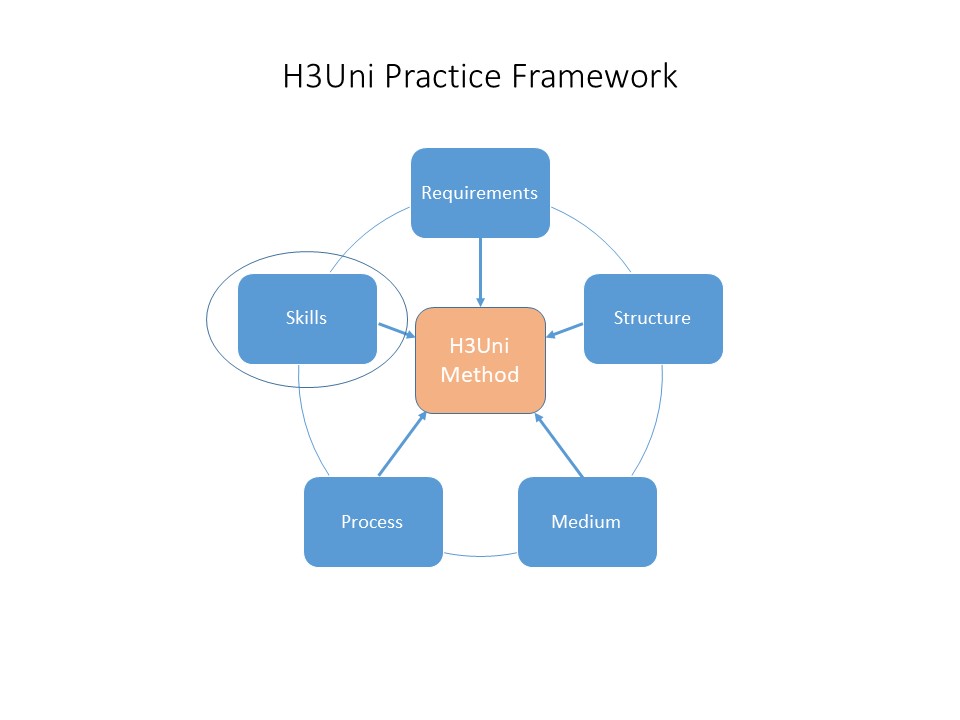 Facilitating collaborative pattern thinking requires the buildup of mental, emotional and physical skills working together. This integration is acquired by a different way of learning than simply being informed. In this sense, pattern facilitation is a practice which, rather like learning a musical instrument, requires repeated application, feedback and insight. Learning is also enhanced by coaching from someone with experience of it.
Facilitating collaborative pattern thinking requires the buildup of mental, emotional and physical skills working together. This integration is acquired by a different way of learning than simply being informed. In this sense, pattern facilitation is a practice which, rather like learning a musical instrument, requires repeated application, feedback and insight. Learning is also enhanced by coaching from someone with experience of it.
It is helpful both for learning and in facilitation events to be practising some kind of mindfulness or presence. Whatever aspect of any skill that is needed has to be deployed in the NOW, the present moment. The closer we are to a flow state the easier the integration actually becomes. This operates at least at three levels. Firstly, it is good to have practised to build reflexes in the different areas. This is like practising scales so as to be able to play runs in an actual piece of music. Secondly, it is good to be able to hold in mind and quickly refer to the facilitation script. This is treated on a kind of ‘management by exception’ basis, explained by the third point which is being intuitively alert to how things are flowing or getting blocked. This is about picking up subliminal signals or behavioural clues (e.g. the level of energy and engagement of the group) and recognizing that the planned process needs real-time adjustment. This may be literally in the instant or it may be in a session break where there is opportunity for a reflective huddle.
The new reflexes that have to be built which enable attention-in-the-moment to be paid to four areas of what is going on in the group fall into four areas.
- The Process Pathway: the briefing of the group on the overall pathway, what the next detailed step is and where it is in the whole process:
- Are you clear at any moment where you are in the designed process?
- Are people in the group clear where they are in the process?
- Does the process need recovering?
- Does the process need adjusting (minor redesign on the spot)?
- Use of Thinking Frameworks: the monitoring of behaviour to see how the group are taking to the process and engaging with it:
- Are tactical corrections needed? For example more or less time on a particular step?
- Is some further concept explanation necessary?
- Operation of Visual Tools: Capturing and manipulating contributions from the group according to the designed process; manipulating these as necessary on the shared visual space:
- Are the tools and spaces for the next step ready to hand?
- Are there photos to be taken for the record?
- Guidance of the Group Process: Being aware of the passage of time, the energy and the need to slow or accelerate the process; sustaining the confidence of the group that the task can be done as they go through unavoidable confusion and sticking points:
- Are people happy with the process so far?
- Do you need to reassure them through a transition (e.g. confusion before new insight)?
- do you need to take time-out to help a confused person to get in tune again?
Being aware of these four aspects will help you in the moment to be aware of what is needed, and will guide you in reflective practice.
Where you will find this
The Method Tutorials and Facilitation Guides are intended to give you what you need to start on developing this overall capacity. In addition to the guidance in each step of the Facilitation Guides there is a final section of tips organised around these four areas of skill.
![]()
Creative Commons Attribution-ShareAlike 4.0 International (CC BY-SA 4.0) license framework.
How to Use this License
CC BY-BY-SA
This license allows reusers to distribute, remix, adapt, and build upon the material in any medium or format, so long as attribution is given to the creator. The license allows for commercial use. If you remix, adapt, or build upon the material, you must license the modified material under identical terms.
Read about Open Access to H3Uni Methods and Materials
